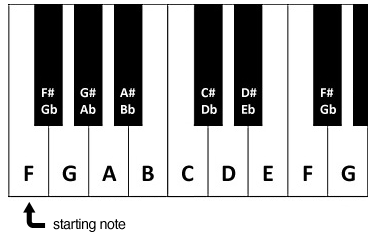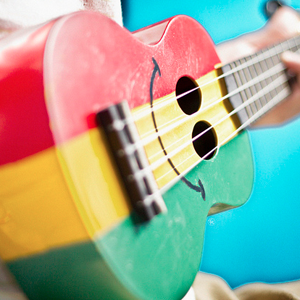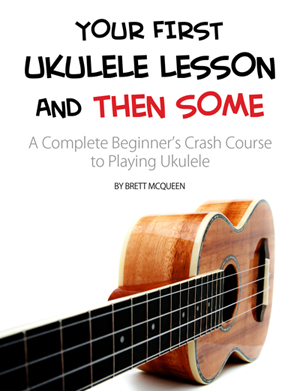This lesson is apart of a larger lesson series that will help us learn the ukulele fretboard. So far, we’ve learned how to play a C major scale and a G major scale on ukulele. Now, it’s time to learn how to play an F major scale.
Scales not only help us learn the ukulele fretboard, but they also allow us to understand the music we are playing. For example, if we know the notes across the fretboard, we can build chords, craft solos, and look at a piece of sheet music and play it.
Each of these lessons build on the other, so if you’re just joining us, you will want to start learning the C major scale first.
Alright. Are you ready? Let’s do this!
How to Build an F Major Scale
First, we want to build an F major scale in theory. This way, when we get to actually playing these scales on the ukulele, we understand what we’re playing.
You might be wondering why I chose to teach an F major scale and a G major scale after a C major scale. If you recall, a G major scale has only one sharp (#). As you’ll find, once we build an F major scale, the scale has only one flat (b). Remember that sharps raise the pitch of a note a half step; flats lower the pitch of a note a half step.
As you remember, a C major scale has no sharps or flats, so it makes sense that the next easiest scales to learn would be a G major and F major, since they are only changing one note from a C major scale.
Do you remember the major scale interval pattern we talked about in the first scale lesson? It is whole, whole, half, whole, whole, whole, half.
Because we want to build an F major scale, we can start on an F note, apply this pattern, and build a major scale. Let’s visualize this on the piano keys.

From F to G, we have a whole step, from G to A, we have a whole step, from A to Bb, we have a half step, from Bb to C, we have a whole step, from C to D, we have a whole step, from D to E, we have a whole step, and from E to F, we have a half step.
From this, we see that the notes found in an F major scale are: F, G, A, Bb, C, D, E, F.
We can see an F major scale represented on a musical staff:

Let’s build an F major by starting on the F note on the 1st fret of the E string.

Notice the pattern of half steps in whole steps in the above example by looking at how many frets separate the notes in the scale.
How to Play an F Major Scale on Ukulele
We want to be able to play an F major scale in five different positions across the ukulele fretboard. To do this, we are going to refer to the C major scale we learned in the last lesson. Again, by now, you should be pretty comfortable and familiar with the C major scale.
Tell me again. What is the only flatted note in an F major scale?
Bb.
All of the other notes in an F major scale are notes we already know how to play on the ukulele. This means we can take each of the five C major scale positions we learned and change all the B notes to Bb.
F Major Scale: Position #1

For this position, assign your index finger to fret any of the notes that fall in the 1st fret, your middle finger to fret any of the notes that fall in the 2nd fret, your ring finger to the 3rd fret, and your pinky to the 4th fret.
Compare this position with the first position of the C major scale. As you can see, it’s not much different. We are just lowering the B note to a Bb on the top string and bottom string.
F Major Scale: Position #2

This position is a little different. For the notes on the top two strings, your four fingers will hover over the 2nd to 5th frets. When you get to the notes on the bottom two strings, your fingers will shift to hover over the 3rd to 6th frets to fret the notes.
F Major Scale: Position #3

Like the last position, for the notes on the top two strings, your four fingers will hover over the 4th to 7th frets. When you get to the notes on the bottom two strings, your fingers will shift to hover over the 5th to 8th frets to fret the notes.
F Major Scale: Position #4

Assign your index, middle, ring, and pinky finger to fret the notes that fall between the 7th and 10th frets.
F Major Scale: Position #5

For the notes on the top two strings, your four fingers will hover over the 9th to 12th frets. When you get to the notes on the bottom two strings, your fingers will shift to hover over the 10th to 13th frets to fret the notes.
Final Notes
By now, you’re probably noticing a lot of the same patterns between the C major, G major, and F major scales. This is nice because your fingers are probably getting used to many of these shapes.
However, since your fingers are getting used to these shapes, you have to be really intentional about saying the notes you are fretting out loud. The goal in all of this is to understand what you’re playing. That understanding will help you in the long run. Shapes will only take you so far.
If you’re looking for some practical ways to apply your newly acquired knowledge of the ukulele fretboard, take a look at my post 3 Easy Songs You Can Fingerpick On Ukulele Today. For each of the songs I teach, I include sheet music. I recommend printing this music off and identifying the notes on the staff and seeing where those notes fall on the ukulele fretboard.
As always, if you have any questions, don’t hesitate to post your comment below! Let’s talk about it.
F Major Scale: All Positions



